Menu

0
Your Cart is Empty

Your Cart is Empty
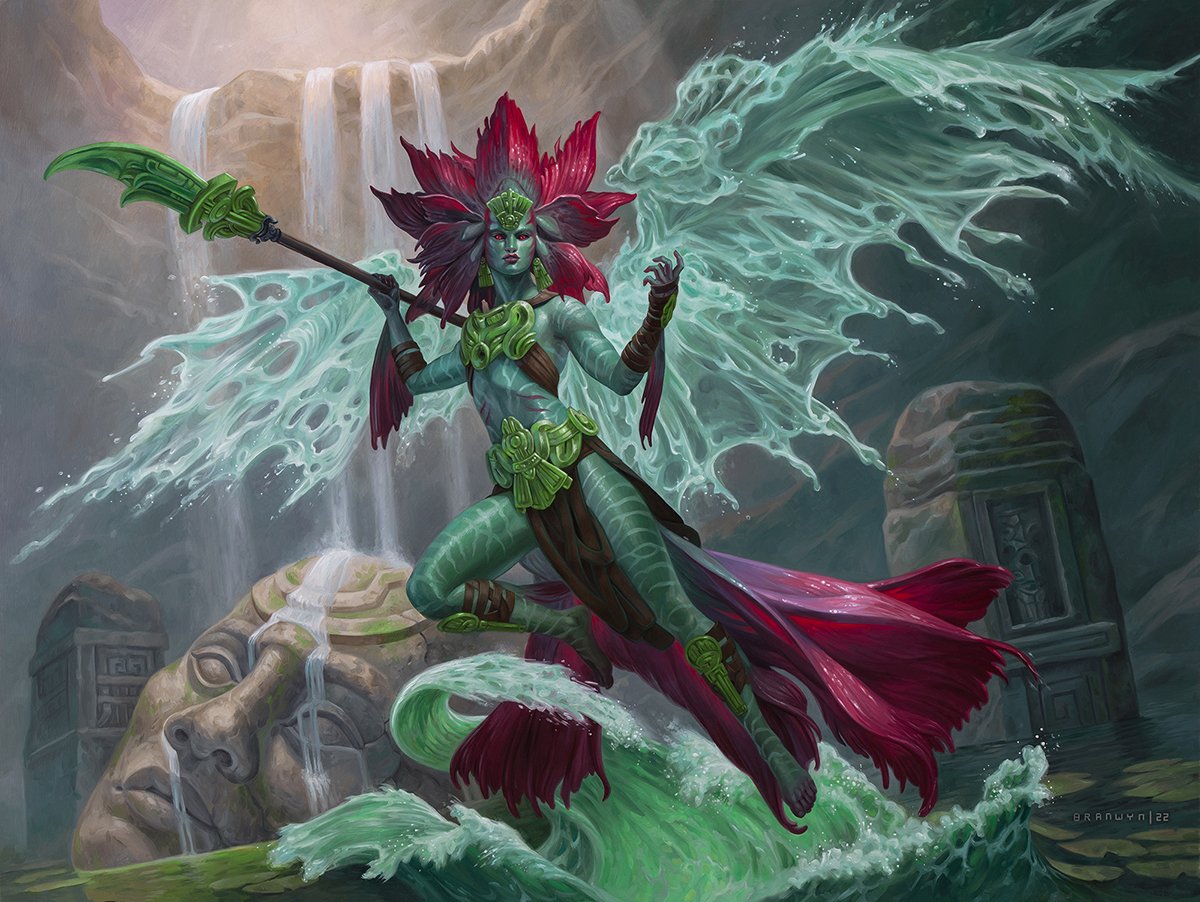
November 20, 2023 7 min read 1 Comment
After much anticipation, the return to Ixalan has arrived with the release of The Lost Caverns of Ixalan. On a personal note, I am pouring out a cold one in recognition of the final set with original draft boosters—only “play boosters” from here on out for Limited. That, however, is an article for a different website.
Here at Original Magic Art, there are numerous angles that could be examined regarding the artwork of The Lost Caverns of Ixalan. This week, I’ve chosen a creative way of studying the evolution of popular creature types in Magic over the years. I intend to take the popular creature types from The Lost Caverns of Ixalan and compare them with one of the earliest instances of the same creature type from Magic’s history.
Side note: in many cases, older cards had creature types errata’d over the years. I am going to respect the creature types cited on Gatherer. Therefore, I’ll respect Fungusaur as a Creature—Fungus Dinosaur rather than the “Summon Fungusaur” type that appeared on the original printing of the card. This will expand my options and provide a little bonus history for those interested.
Let’s begin with a fan favorite creature type, and one best known for roaming the plane of Ixalan: Dinosaurs! The original dinosaur, as I just mentioned above, was Fungusaur from Limited Edition Alpha, Magic’s first set. Let’s compare the art with one of the latest dinosaurs to be printed, Ghalta, Stampede Tyrant.


In this instance, we need to make some allowances for Fungusaur because it wasn’t originally illustrated by Daniel Gelon as a dinosaur. Still, I think it has some dinosaur-like traits—the sharp teeth, the hunched over stature. Gelon even did a nice job painting the surrounding cave environment, giving the piece a bit of texture. Lars Grant-West’s art for Ghalta screams “dinosaur.” The artwork could have seriously been taken out of a promotional poster from Jurassic Park. Clearly, when a card is designed from the start to be a dinosaur, the artwork reflects memories from children’s dinosaur books.
Forced to pick my preference between the two, I’d say Fungusaur wins by a tie-breaking observation: the creature reminds me of Rancor from Return of the Jedi! Do you see the resemblance?
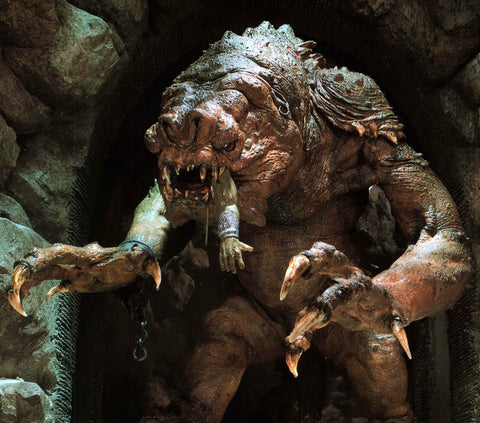
Similarities to Star Wars films aside, I appreciate both the new and old dinosaur artworks evenly for their respective features and style.
Another creature type that shows up repeatedly in The Lost Caverns of Ixalan is merfolk. Once again, this is an OG creature type, as there was a merfolk in 1993’s Alpha release. Let’s compare the original, Merfolk of the Pearl Trident, with the brand-new card Waterwind Scout.

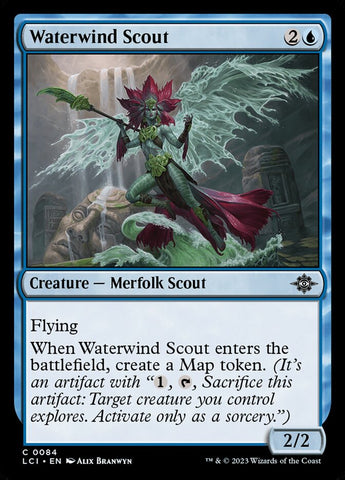
You can really see the age on Jeff Menges’ Merfolk of the Pearl Trident—the artwork looks like it comes from an old card. I love the shading that he implements, though the resulting art is admittedly a bit monochromatic—you have blue, black, and various shades of the two. That’s it. Still, it’s readily obvious that these creatures exist under water. How they don’t have Islandhome and can move on land to attack opponents is a mystery to me.
Shifting focus to Alix Branwyn’s Waterwind Scout, there are many distinct differences between the two. First, Waterwind Scout has legs…and wings?! A walking, flying, swimming merfolk?! That’s not something I would have expected from a water-dwelling creature. I do love the use of additional colors on the pallet beyond blue and black—the red details really pop.
The background is more thought-provoking as well. It looks like the creature is scouting out some ruins from ancient history on Ixalan—naturally the creature is able to reach more places due to its numerous modes of transportation (namely legs and wings).
Seeing as my favorite color is blue, I do have a special appreciation for the OG merfolk artwork. Based on technical merits, however, I have to give the nod to Waterwind Scout. I’m just blown away by the evolution merfolk creatures have experienced over Magic’s 30 year history.
Pirates have always intrigued Magic players—the creature type sparks the imagination because pirates are so popularly depicted in media. The Lost Caverns of Ixalan introduced numerous new pirates to include in players’ decks.
What was the original pirate, though? Technically, the answer is Pirate Ship from Limited Edition Alpha (again). However, I’m going to deviate from Alpha this time because technically the OG pirate is really a ship and not a human. Instead, I’m going to choose another, slightly newer pirate from yesteryear to compare with one from The Lost Caverns of Ixalan.
Let’s instead compare Portal’s Cloud Pirates with the modern Shipwreck Sentry.

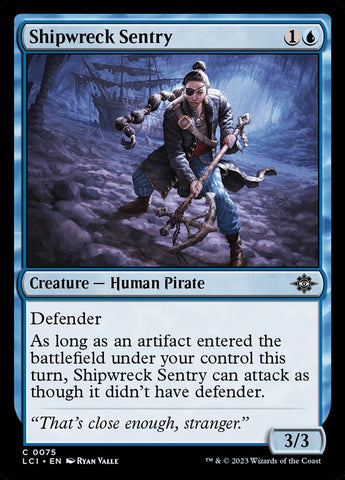
Talk about two very different pieces of art! Cloud Pirates depicts the classic, cartoonish style of Phil Foglio. While the humans illustrated sure look like menacing pirates, their toothy grins are almost comical in nature, taking away from the intimidation the artwork would have otherwise conveyed. Pirates in Phil Foglio’s world look like street performers who recently got their teeth whitened. And where did these pirates get their magic carpets from? Why aren’t they on a ship?
On the other hand, Shipwreck Sentry showcases a “more realistic” looking pirate. The figure depicted is wearing more traditional (and practical) pirate garb, down to the eyepatch detail. She also looks more lifelike and less cartoony—Ryan Valle did a wonderful job on this one. The background tells the card’s story with greater detail, which I appreciate. The wrecked ship in the background is especially ominous.
With all due respect to Phil Foglio, there’s no contest here. I would prefer Ryan Valle’s artwork for pirates any day. Only one of these pieces of art pay homage to the pirate code, and it’s not the one with flying carpets.
There are well over 100 vampires from Magic’s history, going all the way back to Sengir Vampire from Alpha. Since I’ve already done the Alpha thing, I’m going to take artistic license and deviate once again, instead showcasing a lesser known vampire from Magic’s history.
In this case, I’m going to compare the new Vito’s Inquisitor with Ravenous Vampire from Mirage.
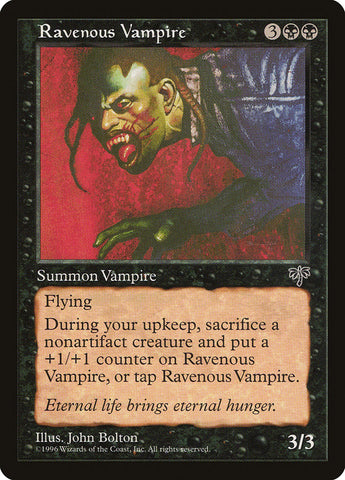
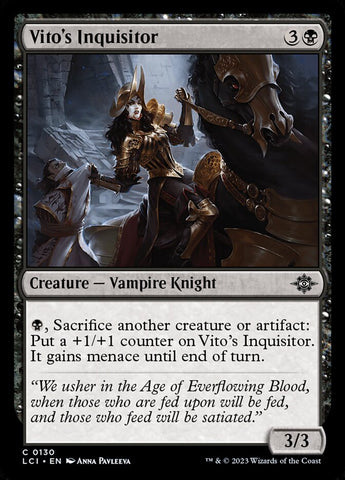
It’s worth noting that Wizards of the Coast doesn’t appear to make regular, garden-variety vampires much anymore. They always have an additional subtype, such as “vampire knight” or “vampire cleric.” In this case, Vito’s Inquisitor is a vampire knight, so she’s sporting armor worthy of a knight. Anna Pavleeva’s artwork really brings the creature to life (or…unlife?) by depicting the vampire mid-attack. I don’t envy the poor individual in her clutches—they are in quite the precarious situation!
John Bolton’s depiction of Ravenous Vampire is an interesting one to say the least. I see the fangs and menacing facial expression that screams “vampire.” The bloodied face is a nice touch. But nothing else in the artwork is suggestive of being a vampire, and there’s no background to explain what’s going on in the artwork either. It’s a strange piece, and it doesn’t really look anything like modern day Magic cards.
I chose this comparison as a way of showcasing the evolution of Magic artwork over the years. Much has changed between 1996 and 2023, and it shows in the art of these two vampires. Modern day Magic cards have much more detail in both foreground and background—I suppose computerized artwork is one big reason for this evolution. Still, there are plenty of physical paintings done nowadays with just as much detail.
In addition to some classic favorites, The Lost Caverns of Ixalan also introduced three new creature types!
First, there’s the Llama, which comes to life when Restless Prairie is activated.
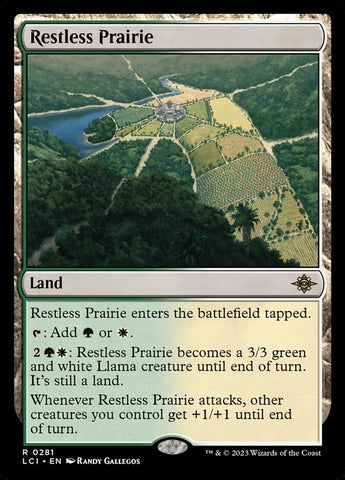
The artwork on the cycle of “Restless” lands each do a marvelous job hiding the creature that comes to life in the landscape depicted. In the case of Restless Prairie, the creature is a llama. Could we see a Universes Beyond Napolean Dynamite series in the future, featuring the famous llama, Tina? One could only dream!
The second new creature type is Snail and shows up on one card: Skullcap Snail.

I am surprised this is the first snail in the history of Magic. There have been other gastropods before—there are eight slugs across Magic’s history. Never a snail, however. Until now. Doesn’t Maxime Minard’s Skullcap Snail look like a slug? I don’t know if it was really worth introducing a new creature type here. Why not just make this one a slug? One of life’s mysteries, I suppose.
Last but certainly not least, my personal favorite: Capybara!
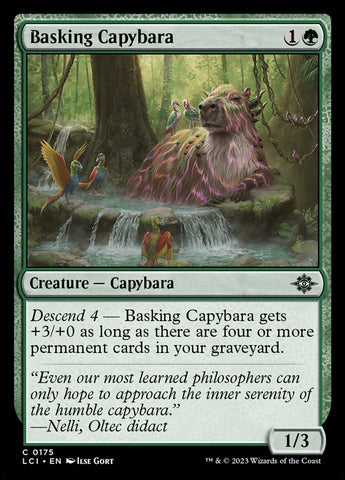
It’s a little-known fact that capybaras are my favorite animals—they’re the largest rodent in the world, but they are so cute! Isle Gort’s depiction of a capybara does a nice job capturing the cuteness of this animal, and I’ll have to make sure to pick up a copy for my collection simply out of homage to the large rodent.
The first time I had ever seen a capybara was on an old kids’ television show, Zaboomafoo. They had a segment on the show where they described an animal, giving viewers an opportunity to guess at the creature they were featuring on the show (skip to 3:25). I’ll never forget the capybara episode—they’re describing a creature that sounded (to me) like a dog of some sort. I was convinced it was a simple, common animal. Thus, my shock when the revealed creature was a capybara. I had never heard of a capybara before that moment. I don’t know how most kids would have had a clue who this animal was.
Well, maybe thanks to Magic and Basking Capybara, that will change.
The Lost Caverns of Ixalan brought us a host of creature types, some old and some new. For the classics like pirate, dinosaur, merfolk, and vampire, it’s interesting to study the evolution of artwork depicting these creatures over the course of Magic’s history. Newer cards certainly hold more detail, but sometimes the original artwork stands out a bit more. It really comes down to personal preference, and my nostalgia for older cards certainly biases my opinion.
Then we have brand new creature types, indicating that Wizards of the Coast is still exploring plenty of white space! It makes me wonder what creature types Wizards will introduce in the next set! The animal kingdom is vast—there are still plenty of animals that could make for new creature types in Magic. Only time will tell!
Sign up to get the latest on sales, new releases and more …